lock CADILLAC DTS 2007 1.G Owners Manual
[x] Cancel search | Manufacturer: CADILLAC, Model Year: 2007, Model line: DTS, Model: CADILLAC DTS 2007 1.GPages: 518, PDF Size: 2.77 MB
Page 1 of 518

Seats and Restraint Systems
....................... 7
Front Seats
.............................................. 9
Rear Seats
............................................. 17
Safety Belts
............................................ 19
Child Restraints
...................................... 42
Airbag System
........................................ 70
Restraint System Check
......................... 88
Features and Controls
................................ 91
Keys
....................................................... 93
Doors and Locks
.................................. 102
Windows
............................................... 108
Theft-Deterrent Systems
....................... 112
Starting and Operating Your Vehicle
..... 117
Mirrors
.................................................. 132OnStar®System
................................... 139
Universal Home Remote System
.......... 143
Storage Areas
...................................... 155
Sunroof
................................................ 157
Instrument Panel
....................................... 159
Instrument Panel Overview
................... 162
Climate Controls
................................... 210
Warning Lights, Gages, and Indicators
.... 222
Driver Information Center (DIC)
............ 240
Audio System(s)
................................... 268
Driving Your Vehicle
................................. 301
Your Driving, the Road, and
Your Vehicle
..................................... 302
Towing
................................................. 340
2007 Cadillac DTS Owner ManualM
1
Page 13 of 518

If you use the remote keyless entry transmitter to
enter your vehicle and the remote recall memory
feature is on, automatic seat and mirror movement
will occur. See “MEMORY SEAT RECALL”
underDIC Vehicle Customization on page 259for
more information.
To stop recall movement of the memory feature at
any time, press one of the power seat controls,
memory buttons, power tilt wheel control, or power
mirror buttons.
If something has blocked the driver’s seat and/or
the steering column while recalling a memory
position, the driver’s seat and/or the steering
column recall may stop. If this happens remove
the obstruction, then press the appropriate control
for the area that is not recalling for two seconds.
Try recalling the memory position again by
pressing the appropriate memory button. If the
memory position is still not recalling, see
your dealer for service.Easy Exit Seat
The control for this feature is located on the
driver’s door panel between buttons 1 and 2.
With the vehicle in PARK (P), the exit position can
be recalled by pressing the exit button. You will
hear a single beep. The driver’s seat will move
back, and if the vehicle has the power tilt wheel and
telescopic steering feature, the power telescopic
steering column will move up and forward.
If the easy exit seat feature is on in the DIC,
automatic seat and power telescopic steering
column movement will occur when the key
is removed from the ignition. See “EASY EXIT
SEAT” underDIC Vehicle Customization on
page 259for more information.
Further programming for automatic seat and
steering wheel movement can be done using the
Driver Information Center (DIC). You can select
or not select the following:
The easy exit seat feature
The memory seat recall feature
For programming information, seeDIC Vehicle
Customization on page 259.
13
Page 25 of 518

Driver Position
Lap-Shoulder Belt
The driver has a lap-shoulder belt. Here is how to
wear it properly.
1. Close and lock the door.
2. Adjust the seat so you can sit up straight. To
see how, see “Seats” in the Index.
3. Pick up the latch plate and pull the belt across
you. Do not let it get twisted.
The lap-shoulder belt may lock if you pull the
belt across you very quickly. If this happens,
let the belt go back slightly to unlock it.
Then pull the belt across you more slowly.
25
Page 27 of 518

The lap part of the belt should be worn low and
snug on the hips, just touching the thighs. In a
crash, this applies force to the strong pelvic bones.
And you would be less likely to slide under the lap
belt. If you slid under it, the belt would apply force at
your abdomen. This could cause serious or even
fatal injuries. The shoulder belt should go over the
shoulder and across the chest. These parts of the
body are best able to take belt restraining forces.
The safety belt locks if there is a sudden stop or
crash.
27
Page 33 of 518

To unlatch the belt, push the button on the buckle.
The belt should go back out of the way.
Before you close the door, be sure the belt is out
of the way. If you slam the door on it, you can
damage both the belt and your vehicle.
Shoulder Belt Height Adjustment
Before you begin to drive, move the shoulder belt
height adjuster to the height that is right for you.
Adjust the height so that the shoulder portion of
the belt is centered on your shoulder. The
belt should be away from your face and neck, but
not falling off your shoulder. Improper shoulder
belt height adjustment could reduce the
effectiveness of the safety belt in a crash.
To move it down, press
the release button (A)
and move the height
adjuster to the desired
position. You can move
the height adjuster up
just by pushing up on the
shoulder belt guide.
After you move the height adjuster to where you
want it, try to move it down without pressing
the release button to make sure it has locked into
position.
33
Page 34 of 518

Safety Belt Use During Pregnancy
Safety belts work for everyone, including pregnant
women. Like all occupants, they are more likely
to be seriously injured if they do not wear
safety belts.
A pregnant woman should wear a lap-shoulder
belt, and the lap portion should be worn as low as
possible, below the rounding, throughout the
pregnancy.The best way to protect the fetus is to protect the
mother. When a safety belt is worn properly, it
is more likely that the fetus will not be hurt
in a crash. For pregnant women, as for anyone,
the key to making safety belts effective is wearing
them properly.
Right Front Passenger Position
To learn how to wear the right front passenger’s
safety belt properly, seeDriver Position on
page 25.
The right front passenger’s safety belt works the
same way as the driver’s safety belt — except
for one thing. If you ever pull the shoulder portion
of the belt out all the way, you will engage the
child restraint locking feature. If this happens, let
the belt go back all the way and start again.
34
Page 36 of 518

Rear Seat Passengers
It is very important for rear seat passengers to
buckle up! Accident statistics show that unbelted
people in the rear seat are hurt more often in
crashes than those who are wearing safety belts.
Rear passengers who are not safety belted
can be thrown out of the vehicle in a crash. And
they can strike others in the vehicle who are
wearing safety belts.
Lap-Shoulder Belt
All rear seating positions have lap-shoulder belts.
Here is how to wear one properly.
1. Pick up the latch plate and pull the belt across
you. Do not let it get twisted.
The shoulder belt may lock if you pull the belt
across you very quickly. If this happens, let
the belt go back slightly to unlock it. Then pull
the belt across you more slowly.
2. Push the latch plate into the buckle until it
clicks.
36
Page 37 of 518

The latch plates for the safety belts in each
rear seating position vary in size. If the center
rear or the left rear latch plate is inserted
into the incorrect buckle, the plate will not latch
properly. Be sure you are using the correct
buckle and that the latch plate clicks
when inserted into the buckle.
When the shoulder belt is pulled out all the
way, it will lock. If it does, let it go back
and start again.
Pull up on the latch plate to make sure it is
secure.
If the belt is not long enough, seeSafety Belt
Extender on page 42.
Make sure the release button on the buckle is
positioned so you would be able to unbuckle
the safety belt quickly if you ever had to.3. To make the lap part tight, pull up on the
shoulder part.
37
Page 38 of 518

The lap part of the belt should be worn low and
snug on the hips, just touching the thighs. In
a crash, this applies force to the pelvic bones. And
you would be less likely to slide under the lap
belt. If you slid under it, the belt would apply force
at your abdomen. This could cause serious or
even fatal injuries. The shoulder belt should
go over the shoulder and across the chest. These
parts of the body are best able to take belt
restraining forces.
The safety belt locks if there is a sudden stop or a
crash.
{CAUTION:
You can be seriously hurt if your shoulder
belt is too loose. In a crash, you would
move forward too much, which could
increase injury. The shoulder belt should
�t against your body.
38
Page 61 of 518

{CAUTION:
Children can be seriously injured or
strangled if a shoulder belt is wrapped
around their neck and the safety belt
continues to tighten. Secure any unused
safety belts behind the child restraint so
children cannot reach them. Pull the
shoulder belt all the way out of the
retractor to set the lock, if your vehicle
has one, after the child restraint has been
installed. Be sure to follow the
instructions of the child restraint
manufacturer.
Notice:Contact between the child restraint or
the LATCH attachment parts and the vehicle’s
safety belt assembly may cause damage to
these parts. Make sure when securing unused
safety belts behind the child restraint that
there is no contact between the child restraint
or the LATCH attachment parts and the
vehicle’s safety belt assembly.Folding an empty rear seat with the safety
belts secured may cause damage to the safety
belt or the seat. When removing the child
restraint, always remember to return the safety
belts to their normal, stowed position before
folding the rear seat.
1. Attach and tighten the lower attachments to
the lower anchors. If the child restraint does
not have lower attachments or the desired
seating position does not have lower anchors,
secure the child restraint with the top tether
and the safety belts. Refer to your child
restraint manufacturer instructions and the
instructions in this manual.
1.1. Find the lower anchors for the desired
seating position.
1.2. Put the child restraint on the seat.
1.3. Attach and tighten the lower
attachments on the child restraint to the
lower anchors.
61